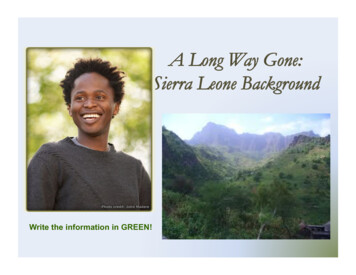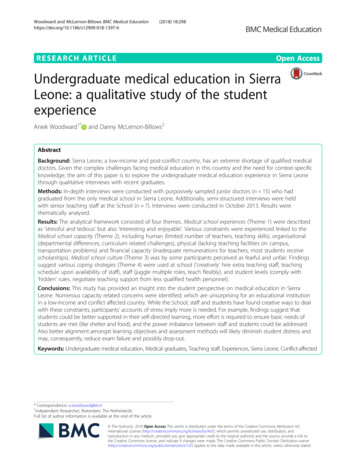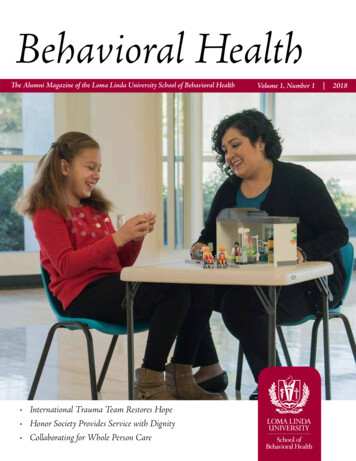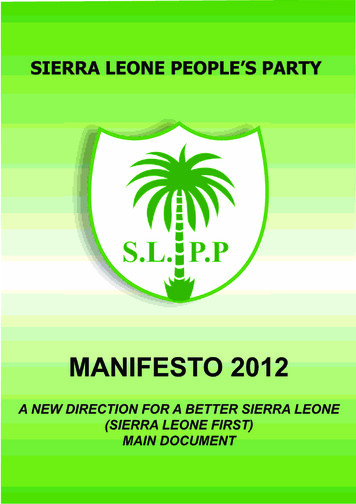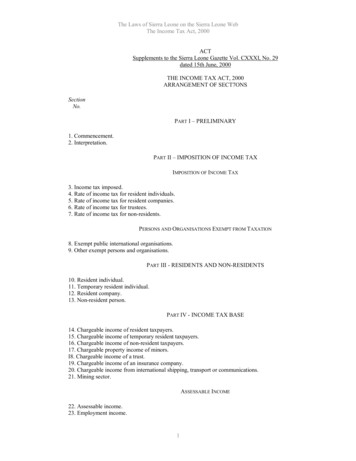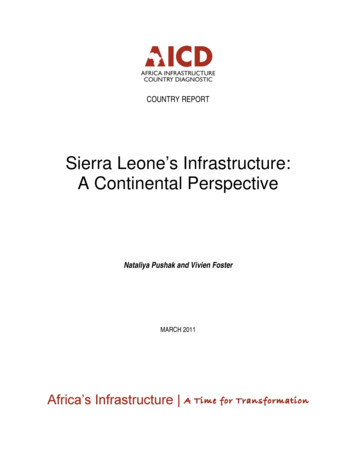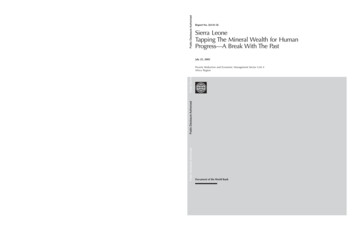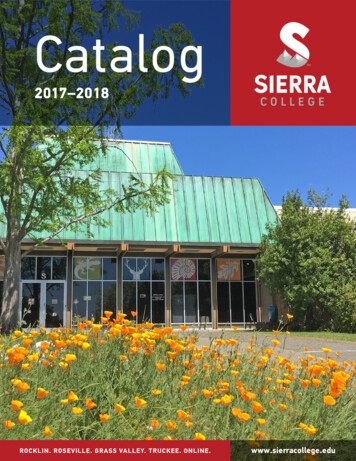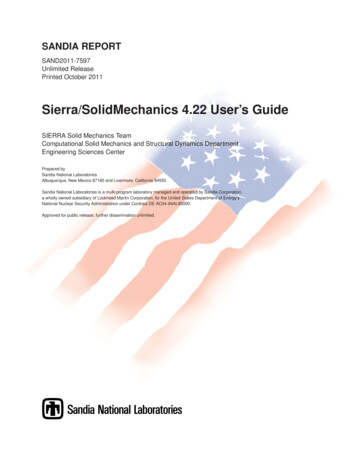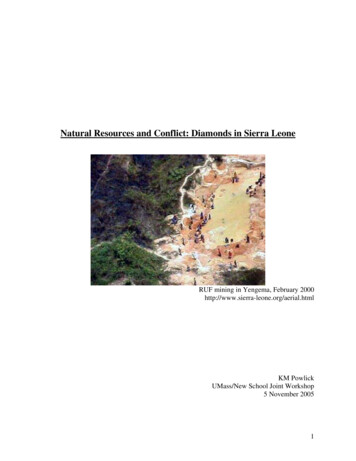
Transcription
March 2003Trip to Sierra Leone by Aiah FandayBefore I traveled to Kono, Ivisited Afrometric Cosmetologyon Garrison Street, and SamKam Institution. Both schoolsapplied for FoSL Small GrantLoan. I found the schools verycredible. Though they werestruggling to make ends meet, Ifound the teachers and studentsin high spirits.The major event on this daywas the donation of 400.00 totheProgressiveWomenAssociation (PROWA) TrainingInstitution Kono District Branch.The event took placed inFreetown because the schooladministrators wanted the eventto be covered by the Media.SLBS carried the event thesame night.I visited theschool’s branch in Kono. I wasvery impressed with theirprogressivecurriculum.PROWA Training Institutionprovidesvocationalskillstraining to war affected and lessprivileged women for selfreliance or independence. Theschool provides training intailoring, gara tie dyeing, batikwork, creative practical arts,soap making, adult literacy,agriculture and traditional birthattendance.After completing training, whichranges from six months to ayear, depending on the careerchoice, successful candidateswill graduate with certificatesigned by the Minister ofEducation–TechnicalVocational Division.Aftergraduation, the graduates areprovided with start-up kits intheirvariousfieldsandencouraged them to go back totheir different communities toserve their people. Some of thegraduates organize themselvesintosmallgroupsorpartnerships.Others gainemployment into the private orpublic sectors.I made a courtesy visit to someof the Amputees Children’sRelativesthatFoSLcosponsored through the Gift ofLimbs Project. They expressedtheir appreciation for what FoSLdid for their families. I sensedno animosity towards us. Noneof the relatives complained thatwe were benefiting financiallyfrom the amputees’ trip to theUnited States.To fulfill another aspect of mytrip, I visited some displacedcamps in the Western Area tosee which camp would benefitmost from our Pep-Project“Feeding Day.” After a followup visit to the Grafton Camp Idecided they would be mosthelped because they were verydesperate for help.On Sunday, November 24, Idelivered 40 bags of rice onbehalf of FoSL to the residentsat the Grafton Camp. TwentySections, made up of roughlyfive thousand displaced people,benefited from our generouscontribution.During ckground of FoSL. I stressedthat the group was formedprimarily by Returned PeaceCorp Volunteers for the love ofthe country and the people theyknew. I told the group that inthe past FoSL has assisted 8child amputees who have beenprovided with artificial limbs andthat together with two adults,the amputees are now stayingin the United States. I urgedFandaycontinued on page 8Inside this Issue:Report from Sierra Leone3Freetown Visit4Sierra Leone Web5Publications6Announcements7. . . . . . . . . . . . . . . . . . . . . . .
Page 2Friends of Sierra Leone NewsletterFriends of Sierra LeoneBoard of Officers & Committee ChairsPresident:Mike Diliberti, Falls Church, VirginiaVice President:Mike O’Neill, Silver Spring, MarylandSecretary:Eunice Blau, Alexandria, VirginiaTreasurer:Mark Hager, Silver Spring, MarylandPublic Affairs 1:Lydia Nylander, Washington, DCPublic Affairs 2:Aiah Fanday, Beltsville, MarylandAt Large 1:Peggy Murrah, Social Circle, GeorgiaAt Large 2:Linda Slonksnes, Alexandria, VirginiaAt Large 3:Adjai Robinson, Baltimore, MarylandAt Large 4:James Sheahan, Atlanta, GeorgiaNewsletter Editor: Carl Onken, Central Valley, New YorkWeb Site Manager: Jamie Brown, Juneau, AlaskaMember Database: Mike Diliberti, Falls Church, VirginiaAdvocacy Co-chair: Judy Figi, Janesville, WisconsinAdvocacy Co-chair: Billie Day, Washington, DCEducation Chair:Cynthia Barron, Mt. Ranier, MarylandProjects Co-chair: Linda Slonksnes, Alexandria, VirginiaProjects Co-chair: Aiah Fanday, Beltsville, MarylandMarch 2003Survey ofSierra Leone RPCVswho served in the 1960sDid you ever wonder what makes us so attached to Sierra Leone?Many people have commented that people who work in SierraLeone make more of an effort to keep up contacts, return andcontinue to help out than those who have worked in other countries.One of our Board members, Adjai Robinson, would like to see ifthere is an aspect of working in Sierra Leone that is unique. Hewould like to begin with a survey of the RPCVs who experiencedSierra Leone in the 1960s. After this analysis, he will surveyRPCVs from the 1970s, 80s and 90s in turn.Please go to the http://www.fosalone.org/ website to view and fillout the survey – but only if you served in the 1960s. Others willhave their turn in future surveys. You can either fill in the surveyonline where it will be sent directly to Adjai,, or print it, fill it outand mail it to our post office box. Be sure to mark the envelop“1960s Survey.” Do it now – don’t delay.Are you ready to go back to Sierra Leone in 2004?The FOSL Board has proposed tohold the 2004 Annual Meeting in inFreetown. Are you interested inattending? Before we pla n for thisevent we need to hear if there issufficient interest on the part of ourmembers and donors. An AnnualMeeting in Freetown would entail anenormous planning effort, but we feelthat the time is right for us to help celebrate the end of hostilities and renew our direct contacts with SierraLeoneans in Sierra Leone. In addition to a program in Freetown, we would include an opportunity to travelupcountry. If you have an interest in attending (this would not be a commitment, only a statement of interest),go to “2004 Freetown Annual Meeting” on our http://www.fosalone.org/ web site and give us your name, phonenumber, email address, and how many people are interested in attending. If there is sufficient interest, we willget back to you with a tentative date and cost estimates. If you do not have access to the internet, send a letteror postcard to our P.O. Box and indicate on the envelope “Freetown Annual ---------------------------------------------2003 Annual Meeting on the West Coast: The 2003 FOSL Annual Meeting will take place inPortland, Oregon on August 1-3, 2003 in conjunction with the annual NPCA Conference. Further informationwill be mailed out and included in future Newsletters.2004 Annual Meeting tentatively planned for Freetown, Sierra Leone .2005 Annual Meeting will be held on Sapelo Island, Georgia . You may recall that this is theisland where the Mende song featured in the documentary The Language You Cry In was passed on throughmany generations of an African-American family. Here is a web site with additional information on SapeloIsland: http://www.accessatlanta.com/ajc/projects/gullah/.
March 2003Page 3Friends of Sierra Leone NewsletterReport from Sierra Leone by Les and Hope LawLet me tell you more about SierraLeone. The buildings at HarfordSchool in Moyamba are still ingood structural shape, but thereare doors missing and glassbroken out. Most of the desks andchairs are gone, apparently usedfor firewood, and the library booksare completely gone. Most of theschools we visited were in thesame shape. The day we werethere the rains were so bad wecould hardly see. Damage at theRotifunk hospital was severe. Thebuildingstherewere100%destroyed. Everything is gone.The government has built a smallhealth clinic there now.Thehistoric old church at Rotifunk isalmost destroyed.Freetown is very crowded. A lot ofpeople are still too scared to moveback up country. The UN is doinga great job there.They arecontributing to keeping the peacevery well, and they are providingtransportation to get people backup country.We passed oneconvoy of 15 or so big trucksmoving people up beyond Bo. Wewere told that Freetown is notnearly as crowded now as it waswhen the war was on.Up country, the infrastructure isalmost completely destroyed androads are really bad due to lack ofmaintenanceandwar-relateddestruction.The educationsystem is badly weakened and thehealth system is a mess. Manypeople who have jobs are notgetting paid. The general thoughtis that roads or transportationneed to be the first priority.Communication is the only thingmuch better than when we werethere in the 60's. As you drive upcountry through the jungle (thejungleissufferingfromdeforestation), you suddenly comeupon microwave towers.Cellphones are everywhere. Enoughpeople have cell phones so thatcommunicationisgood.Obviously most people don't havecell phones but there are a lot ofthem. We visited a private venturein the formative stages to providehealth care in Kabala. The Kabalahospital and clinic was destroyedduring the war. Very few want togo back to Kabala as it is so faraway.Another thing we saw waseveryone working. Remember inthe 60"s the attitude was that ifyou were educated you did nothave to do physical work. Whenwe were there, at the BaomaSchool, hand making blocks, andtearing apart walls for windows,the Principal and teachers wouldcome out during their breaks andafter classes, roll up their pantlegs, take off their shoes, andwork and sweat with us. We alsosaw a lot of self help programsactually working. We also noticedmen taking care of children,actually in a nurturing way, wherein the 60's it was unusual to seemen recognizing the existence ofchildren, except perhaps in a gruff,disciplining, way. The people, inmy opinion, were shocked at thewar, learned about themselves,and really are trying to make sureit does not happen again. It isreally inspiring.But there are thousands of peoplein Freetown with nothing to do.We were there during the longvacation, so there were youngmen, and women, wandering thestreets. We were confronted onceby a group of young men – highschool age boys – accusing us oftaking advantage of the situation.The situation was diffused ratherrapidly, but it was an example ofthe frustration still present. Theremay be some underlying angerthat needs to be dealt with.Getting people back to work and inschool will help.Also gettingpeople paid for their work will help.Everyone suffered because of thewar, but, the attitude of the peopleis unbelievable. They are veryfocusedonneverlettingsomething like this happen again.Thegovernmentandthechurches, and the mosques, areall preaching forgiveness. Theyare trying to incorporate the rebelsand the victims back into thesociety.They feel they mustforgive or they do not have achance of succeeding in thefuture. People ask, "How can Iforgive someone who raped mydaughter and killed my mother?"Then they add, "No matter howdifficult it is, I know I must verywhere we went.(The Laws were teachers atHarford School for Girls inMoyamba during the 1960’s.)
Page 4Freetown Visitby Skep NordmarkI recently had the good fortune toreturn to Sierra Leone and I wasasked by Mike Diliberti to providesome reflections. The purpose ofmy visit was to help evaluatepossible new embassy sites,specifically a site off Regent Roadnear Leicester Peak. Unfortunatelyit was a very brief trip, spententirely in the Freetown area, sodid not get a chance to get upcountry where I enjoyed most ofmy Peace Corps time.Iunderstand that a lot of up-countryembassy travel is done byhelicopter due to the deterioratingroads outside of the western area.Thehabitof"rewarding"distinguished visitors with chickensis still in place as the embassyPol/Econ officer was provided withthree after a village visit.Notknowing what to do she left them ina bag in the embassy vehicle tosay welcome to Salone to anAssistant Secretary upon hisarrival. Three chickens would havebeen cause for a party at theKabala rest house.The trip in to Lungi is apparently alot easier now that SNBrusselsAirlines is flying a BrusselsAbidjan-Freetown-Banjul-Brusselsloop twice a week. The trip fromLungi to Freetown is not as easy.Apparently only one of the ferries isstill working, and only runs once aday (if that), so travel from theFriends of Sierra Leone NewsletterMarch 2003airport is usually by helicopter.There was only one helicopterworking at the time, which seatsabout twenty people with luggage,so your wait can be awhile if yourluggage gets off last.Afteravoiding mosquitoes and wishingfor a Star beer in a hot Lungihangar for over an hour, thehelicopter, which barely seemedable to get off the ground, takesyou to the Heliport near theAberdeen Bridge.bustling. The only real constructionI saw was for an international courtcomplex near the closed BrookfieldHotel. The construction involvedthe removal of a large cotton tree,so the local tabloids wereexpecting bad juju for the complex.There was a lot more developmentand activity in the Cape Sierraarea, but erosion was noted on theonce beautiful beach betweenthere and the AtlanticClub.Our arrival was relatively late in theevening, but the first thing I noticedwas the amount of people. Thiscould be expected near theHeliport, but was evident in allareas at all times. We got to viewFreetown and potential embassysites from a UN helicopter, whichwas impressively beautiful from theair, but teeming with people whenon the ground. I subsequentlyfound out the population inFreetown is estimated at close toone million, which is four times theestimate in the late 70's, so with nonoticeable road improvements thirdworldtypecongestionwascommon. Taxies and lorries wereeverywhere, and the quality of thedrivers was much the same.Thelocalgovernmentandprofessional people I met with gavepositive responses to everythingasked, even if it may not be true orpossible, just like when I was aPCV. The Sierra Leone peopleseemed to be as friendly as before,always with a greeting, with a fewmore beggars noted, and not asmany young amputees as I thoughtI would see based on what I hadbeen reading.The ex-patcommunity I noticed was mostlyassociated with embassies or UNactivi ties, with most seeming toenjoy Sierra Leone. And although Idid get to enjoy a few Star beersduring my stay, I did not get thechance to drink palm wine again,and could not convince theembassypersonneloftheadvantages of chop, and only gotto eat chop (ground nut) once.Not much seemed to havechangedintheplacesIremembered. There were severalheavily damaged buildings near theembassy, such as the City Hotel,but the old Peace Corps Officeseemed in okay condition and themarket in Victoria Park was stillFoSL Advocacy: Conflict DiamondsSkep Nordmark is a RPCV (1976to 1978) and is now aDepartment of State engineer.by Judy FigiIn January 2002 the U.N. Security Council supported the creation of a diamond certification scheme that would combat worldtrade in illicit diamonds and stop them from being used to fund wars in Africa. The Kimberly Process Certification Scheme is theresult of negotiations between diamond producing and importing countries and diamond industry representatives. It establishesinternational standards of national certification for the trade in rough diamonds. In November, the U.S. joined 44 other countries insigning the Interlaken Agreement, pledging to implement the Kimberly Process and eliminate conflict diamonds frominternational trade. The Bush Administration feels that legis lation by the U.S. Congress is also necessary and is working withCongress to pass legislation as soon as possible.I recently spoke to Michelle Gavin, Legislative Assistant to Senator Russ Feingold (D-WI), Chairman of the AfricanSubcommittee of the Senate Foreign Affairs Committee, who has been a strong supporter of legislation that benefits Sierra Leone.She said that a Senate bill is being prepared and that Feingold would like support from FoSL members through their congressmen.When I have further information on the Senate Bill I will post it on the FoSL website. You can also keep track of the status oflegislation by checking the Congressional Website at http://thomas.loc.gov and typing in Sierra Leone.
March 2003Friends of Sierra Leone NewsletterPage 5The Man Behind the Sierra Leone Webby Etta TouréSierra Leone has been through one of the cruelest wars in recent history. Over the last decade, almost everyone inthe country has been displaced at one point or another, and almost everyone has lost one or more relatives. Today,the war is over and the country is trying to rebuild. However, much of this will depend on others. With help frommajor international donors, supplemented by organizations such as Friends of Sierra Leone, there is good reason tobelieve that Sierra Leone will pull through and sustain peace.This section is dedicated to others helping to rebuild Sierra Leone. If you know of an individual or group that ishelping Sierra Leone, please share their stories with us. This quarter, our feature is about the man behind the SierraLeone Web - Peter Andersen (mailto:andersen@sierra-leone.org). In this publication, we have also included weblinks to other volunteer groups that are providing assistance to Sierra Leone.Peter Andersen is a Returned Peace Corps Volunteer who served in Sierra Leone between 1979 and 1982. His lovefor Sierra Leone awoke a commitment to tell the story of Sierra Leone to a world community that is quicklyreachable via the Internet. Unassuming and practical, Peter describes himself as "just a guy with a Pentium 90computer." Thanks to Peter and his Pentium 90 computer – now a Pentium III, people searching for reliable, andobjective reporting on Sierra Leone have come to accept http://www.sierra-leone.org as the first source for SierraLeone news.The late eighties and most of the nineties were years of upheaval and tragedy in Sierra Leone. However, mainstreammedia did not always cover news and events in Sierra Leone. Even the small number of articles on Sierra Leonewhich made it on the newswires died an electronic death. They were never published. In fact, even when the firstonline services were rolled out in 1994, some of the wire service reports on Sierra Leone were limited to payingsubscribers and not accessible by the general public.Believing that it was important to tell the Sierra Leone story, Peter created the website, http://www.sierra-leone.org,- arguably the first Internet website to provide news and information on a single country – Sierra Leone!http://www.sierra-leone.org also provides press releases, texts of relevant government documents, transcripts ofspeeches, links to other Sierra Leone news sources, as well as images of Sierra Leone and its people.Peter launched the Sierra Leone Web in late February 1996, just in time to meet the great demand for Sie rra Leonenews when the AFRC coup of May 1997 happened. Suddenly there was a scramble to find immediate informationon Sierra Leone, as the events were fluid and rapidly affecting thousands of lives. During this time, Peter spent nearsleepless nights juggling his time between his job-for-pay and meeting his commitment to a world community thatnow depends on his reporting on http://www.sierra-leone.orgToday, with some outside funding, Peter still uses his personal financial resources and spends countless hourswithout compensation to continue telling the world about Sierra Leone on http://www.sierra-leone.org. He has madetrips back to Sierra Leone to stay current on the country and its people; and has cultivated a vast network of sourcesin and out of Sierra Leone to complement his uncompromising style of journalism.As one of its own, Friends of Sierra Leone salutes Peter Andersen, for a job well done!The following are web links to other groups that you may consider as additional ways to support Sie rra Leone.1. Operation Classroom: http://gbgm-umc.org/nwo/98jf/classroo.html2. African Youth Movement - http://www.africanartville.org/index.htm For more informationcontact - Abu Hassan Kamara (Askia) - mailto:askia@hotmail.com3. Sierra Leone Relief: http://www.sierraleonerelief.com4. Habitat for Humanity: http://www.habitat.org
Page 6Friends of Sierra Leone NewsletterMarch 2003Recent Publications on Sierra Leone and Information LinksHuman Rights Watch issued a report on January 16, 2003: Sierra Leone: Sexual Violence Widespread in War.The Human Rights Watch report, which is based on hundreds of interviews with victims, witnesses and officials, detailscrimes of sexual violence committed primarily by soldiers of various rebel forces – the RUF, the Armed Forces RevolutionaryCouncil (AFRC), and the West Side Boys. The report also examines sexual violence by government forces and militias, aswell as international peacekeepers. Here is the web address: http://www.hrw.org/press/2003/01/sl0116.htm.The Freetown newspaper, Awoko, has a web site with articles on Sierra Leone’s local and national news and informationon Sierra Leone. The web address: http://www.awoko.com/ .Check out the web site: http://free.freespeech.org/isierra-leone/cuisine/ to find recipes for dozens of Sierra Leonean dishes.It’s a real find, and there’s more than just recipes on this site. Please note the spelling (i.e., isierra) or you’ll have troublefinding it.Blood Diamonds: Tracing the Deadly Path of the World’s Most Precious Stones, a book by GregCampbell. See review in the last FOSL Newsletter. Here is an abridged note from the publisher: Blood Diamonds is thegripping tale of how diamond smuggling works, how the rebel war has effectively destroyed Sierra Leone and its people, andhow the policies of the diamond industry – institutionalized in the 1880s by the De Beers cartel – have allowed it to happen.Award-winning journalist Greg Campbell traces the deadly trail of these diamonds, many of which are brought to the worldmarket by fanatical enemies, including the Al Qaeda network. These repercussions of diamond smuggling are felt far beyondthe borders of the poor and war-ridden country of Sierra Leone, and the consequences of overlooking this African tragedy, asthe world has seen, are both shockingly deadly and unquestionably global.How de Body?: One Man’s Terrifying Journey Through an African War, a book by Teun Voeten(Translated by Roz Vatter-Buck). Abridged note from the publisher: In 1998, Acclaimed Photo Journalist Teun Voetenheaded to Sierra Leone for what he thought would be a standard assignment on the child soldiers there. But the cease-fireended just as he arrived, and the clash between the military junta and the West African peacekeeping troops forced him tohide in the bush from rebels who were intent on killing him. How de Body? is a dramatic account of the conflict that raged inthe country for nearly a decade, and how Voeten nearly became a casualty. The book is also a tribute to the people who nevermake the headlines: a BBC correspondent who eventually helps Voeten escape; a school principal who risks his life to keephis students and teachers going amid the bullets and raids; and a priest who runs a safe haven for former child soldiers; amongothers. The book includes stunning black-and-white photos from his multiple trips to the conflict area.Remote Corners: A Sierra Leone Memoir, a memoir by Harry Mitchell. Synopsis: Originally written on aportable typewriter some 40 years ago, this volume (with some recent revisions and updates) is based on Mitchell'sexperiences from 1954 and 1959 as an administrative officer in Sierra Leone. It is written in a personable, informative, andhumane style, describing the author's social and work life, observations of the inhabitants and his fellow colonialists, politicalchanges, and his own personal development brought about by the challenges of life in Sierra Leone. Includes b&wphotographs taken by a contemporary of his in the mid-1950s.Ambushed: A War Reporter’s Year on the Front Lines, a book by Ian Stewart. From the publisher: IanStewart has reported from some of the most dangerous places on earth, but none was more dangerous than Sierra Leone.When armed rebels entered its besieged capital in 1999, Stewart and two of his Associated Press colleagues were ambushedwhile driving down the street on assignment. One of them was killed instantly, and Stewart was shot in the head. He had a 20percent chance of surviving. Miraculously, he did. With frankness, Stewart tells the story of his own remarkable recovery aswell as the extraordinary risks he and other journalists take to report the news from remote war-ravaged countries. Ambushedis a glimpse inside the often surreal world journalists inhabit as they bear witness to violence and give voice to theunspeakable. Though his stories are sometimes buried deep inside the daily papers, or not published at all, Stewart keepsreporting. What finally stops him is a bullet. With the same determination and courage that served him well as a journalist, heovercomes a brain injury that could have been debilitating.
March 2003Friends of Sierra Leone NewsletterSierra Leone Publications and Information LinksPage 7(continued)The Devil That Danced on the Water: A Daughter’s Quest, by Aminatta Forna. An abridged review fromPublishers Weekly: Forna saw her father for the last time when she was 10 years old. In this harrowing memoir-cum-detectivestory, journalist Forna searches for the truth about her father's execution for allegedly attempting a coup upon the government inwhich he had once been a cabinet minister. Mohamed Forna, a British-educated doctor and activist in what was, in the 1960s, afledgling democracy extricating itself from British colonialist rule, resigned from what had become a dictatorship rife withcorruption and chaos. The consequences of that resignation culminated in eight executions and precipitated the descent intoanarchy of Africa's poorest nation. Forna writes with a compelling mix of distance and anguish, intent on explaining her father'sdeath and reclaiming his memory. Reminiscent of Isabelle Allende's House of the Spirits, Forna's work is a powerfully andelegantly written mix of complex history, riveting memoir and damning expos. The World (NPR radio) broadcast an interviewwith Ms. Forna on February 4th . You can hear it at this link: ml. Ms.Forna will also appear at some bookstores across the country. You can also read a review of this book in the Washington Postat: 5-2003Feb13.html.Conference and Art ExhibitArt About the Sierra Leone Civil WarThe conference will be held at the Play Circle, Memorial Union,University of Wisconsin – Madison: February 28 – March 1The exhibition at the Potter Butts Gallery, Memorial Union,University of Wisconsin – Madison: March 1 - 30For more details regarding the conference and the artists, see:http://www.africanartville.org/ and http://sierraleonetravels.com/Kevin Lowther’s article in American Legacy MagazineAmerican Legacy magazine's Spring 2003 edition, which will be on the newsstands in early February,will carry a feature article by Kevin Lowther (RPCV, Sierra Leone 1963-1965) tracing the roots of thecolonization movement, which began sending free blacks from America to Liberia in the early 1800s.What is generally forgotten is that the first shipload of settlers sailed to Sherbro Island in 1820. When thisfirst settlement proved disastrous, the American Colonization Society found an alternative area furtherdown the coast in 1821. It was later to be called Liberia. American Legacy is a companion magazine toAmerican Heritage and focuses on African-American history and culture.SIERRA LEONE IV 1963-5 REUNION.SL-IV (mainly secondary school teachers) plans to hold its fourth reunion (since returning from SL)in Boston the weekend of September 26, 27 and 28, 2003. (This will mark the 40th anniversary of whenthey finished training at Cornell and flew out of New York City for Sierra Leone.) Although these reunionshave been organized and conducted by people in our group, SLRPCVs from the other groups and SierraLeoneans have always been welcome.
Page 8Friends of Sierra Leone NewsletterMarch 2003Fanday continued from page 1the elders at the camp to make sure that all residents benefited from the gift. I also expressed the hopethat the donation would mark the beginning of a good relationship between them and FoSL.Receiving the rice on behalf of the Grafton Camp, the Acting Camp Chairman, Hassan Ajami Sesay,commended FoSL for the gesture, and prayed for God’s richest blessings for the donors. Mr. HassanSesay gave the assurance that the gift would surely reach the intended beneficiaries. The Camp ViceChairman, Alusine Bangura, in commending FoSL for the donation, also highlighted problems facing thecamp residents, including the unavailability of ration cards and the reduction in family sizes. The CampChairlady, Kumba Maabay, expressed concern over the action of aid agencies operating in the Camp thatsliced the number of camp inmates and dependants from 12,200 to 8,500 and the decision of the WorldFood Program and the National Commission for Social Action not to honor lost cards.FoSL received numerous praises from different quarters. Both air and print mediums carried the story fordays. I have no reason to doubt that we did the right thing at a very desperate time. Like the ProgressiveWomen Association Learning Center, the camp residents were very impressed and appreciative.Aiah Fanday on his visits in Sierra Leone.
March 2003Friends of Sierra Leone NewsletterPage 9Una Kushe-O,As a volunteer organization that squeezes the most from every penny we have, we take advantage of opportunities asthey arise to maintain our person to person in-country contacts. Over the last few years, a number of FoSL Board membershave traveled to Sierra Leone, for work, volunteer, or family-related purposes. In each case, we were able to renew personalcontacts with FoSL’s friends and aid recipients, check on prospective new recipients, and make contact with local media to keepFoSL in the news. So far, these trips have been at no cost to FoSL. This allows FoSL to maintain our focus on assisting SierraLeoneans throughout the country. The Board recently approved funding of five small-grant projects for a total o
Portland, Oregon on August 1-3, 2003 in conjunction with the annual NPCA Conference. Further information will be mailed out and included in future Newsletters. 2004 Annual Meeting tentatively planned for Freetown, Sierra Leone. 2005 Annual Meeting will be held on Sapelo Island, Georgia. You may recall that this is the
